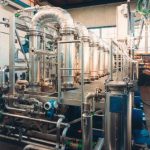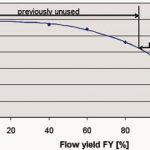The process wastewater occurring in membrane manufacture contains not only soluble and insoluble pollutants from the manufacturing process, including PVP, PES and PA, but also larger amounts of the solvent N-methylpyrrolidone (NMP). An ultrafiltration plant from Amafilter has been in use since April last year for the purification of this process wastewater.
The aim of the water treatment process is to recycle the NMP, whereby a multi-stage distillation process takes on the tasks of concentration and extraction. One prerequisite of the efficient execution of this thermal process is the prior purification of the process wastewater flow containing NMP. Purification is effected by means of a ceramic ultrafiltration membrane, which on the one hand is both solvent and temperature-resistant and on the other demonstrates the required separation limit of 1000 g/mol.
In 2003 Amafilter built and commissioned two ultra-filtration plants for the purification of process wastewater containing solvents (Fig. 1). The process runs stably at solvent content levels of around 7.5 % by weight and at temperatures ranging from 90 to 95 °C. The two plants have a processing capacity of 7 m³/h and 3.5 m³/h respectively and a membrane surface area of 200 m² and 100 m². The membrane areas are arranged in seven re-circulation loops in accordance with the so-called feed and bleed system. The medium is gradually concentrated in the loops, which follow on from each other, meaning that the installed membrane area is used in an optimum manner. In contrast to this, the membrane area in an existing plant was used less efficiently. Large parts of the area in this plant were combined into one stage. The permeate yield set in this stage led to a high load on all the membrane elements and to a relatively low specific permeate flow (Fig. 2).
Toxic waste minimised
A decisive contributor to the overall economy of the process is the fact that the flow of concentrate to be disposed of as toxic waste is minimal. The special challenge lay, therefore, in achieving the objective of an overall yield of 99 %, corresponding to a concentration factor of 100. The permeate contains the purified solvent which, after the water has been removed by means of multi-stage distillation, is re-fed into the production process to be used again. The energy expended for the necessary cross-flow by means of the recirculation pumps is exploited extremely effectively, as the feed is preheated by the permeate and the permeate cooled in this manner is then used to cool the re-circulation loop. This cooling and re-heating of the permeate enables the process to be operated without a cooling system (and the costly associated external cooling) under normal conditions. Although there is still a connection to the existing water cooling system, it is only used to safeguard the process.
Process safely under control
The plant was commissioned in April 2003 and so far the design data has been confirmed in all respects. In particular, the difference in comparison to an older, existing plant is significant. Whilst in the old plant a lot of manual intervention was required in order to maximise the permeate yield, an intelligent control concept now guarantees that even media which do not conform to the design can be concentrated to the maximum possible degree. The last loop, in which the final concentration is achieved, is used here as an indicator. The concentrate outflow is adjusted fully automatically whenever the viscosity reaches its maximum value or the permeate flow is at a minimum. In addition, and as a preventative measure, individual loops are cleaned in a brief but efficient operation whilst the rest of the plant continues to operate, resulting in safe and sure process management coupled with a constant high level of plant availability.
cpp 433
Share:








